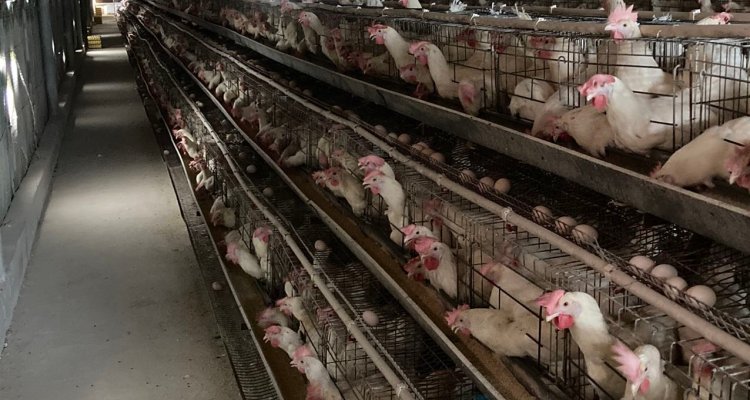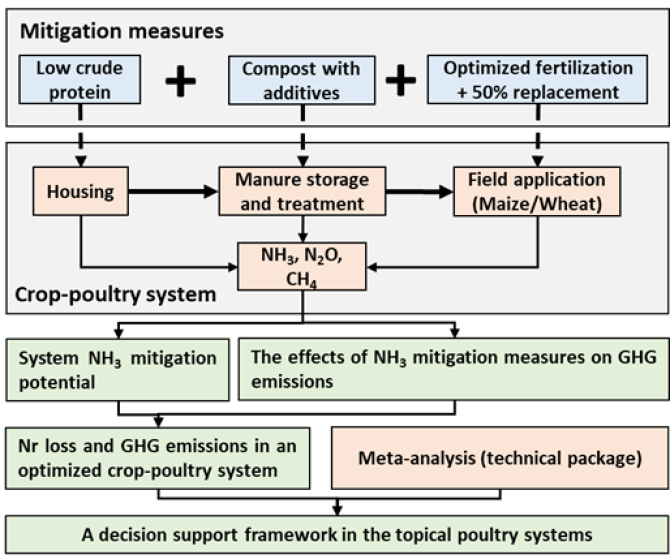
Project
Mitigation of NH3 emissions and accompanying impacts on nitrogen losses and greenhouse gas emissions in cropping-poultry production systems
The disconnection of crop and livestock systems has resulted in manure waste and enhanced chemical fertilizer use with associated losses in the agricultural sector, threatening ecosystems, climate and human health. This project contributes to an enhanced understanding of the role of an improved circular crop-livestock system combined with NH3 abatement technologies om reducing NH3 emissions and the accompanying changes in reactive nitrogen losses and greenhouse gas emissions. Results can aid the identification of targeted manure management interventions and benchmarking and monitoring of sustainable poultry production practices.
Introduction
Feeding the growing and increasingly affluent human population causes huge pressures on animal sources of protein production. Livestock production, including poultry systems, has been rapidly transformed from small-scale extensive production to large-scale intensive production, concurrent with a decoupling of crop-animal production systems. Due to this transition, a significant amount of manure nitrogen (N) is lost into air and water bodies, adversely affecting the environment and ecology, and posing serious risks to human and ecosystem health. The separation of livestock systems from crop systems, in combination with improper manure management, also contributes significantly to climate change, due to direct and indirect N2O emissions and CH4 emissions. The urgency of mitigating these environmental hazards is therefore emphasised in the United Nations 2030 Agenda for Sustainable Development.
Objectives
This project aims to explore the mitigation potential of recoupling poultry systems with local cropland and enhancing improved practices in the manure management chain on NH3 emissions, and associated reactive other nitrogen losses and greenhouse gas emissions.
Methods
Data from a large scale in situ experiment, carried out Quzhou County, combined with a literature review, are used is used to:
- Assess the impact of NH3 mitigation measures at housing, manure storage and treatment, and field application stages on NH3 emissions from a coupled crop-poultry system
- Assess the accompanying impacts on reactive nitrogen losses and greenhouse gas emissions in this coupled crop-poultry systems
- Develop and apply a framework for reducing reactive nitrogen losses and non-CO2 greenhouse gas emissions in typical poultry systems.

(Expected) results
Results include papers on the:
- Quantification of the NH3 mitigation potential in crop-poultry systems
- Evaluation of the impacts of NH3 mitigation measures on greenhouse gas emissions in crop-poultry systems
- Quantification of the response of reactive nitrogen losses and greenhouse gas emissions to NH3 mitigation measures
- Establishment of a framework to reduce reactive nitrogen losses and greenhouse gas emissions in typical poultry systems
Publications
- He, Z., Y. Zhang, X. Liu, W. Xu, Y. Hou, H. Wang and F. S. Zhang, 2022. Ammonia mitigation potential in an optimized crop-layer production system. Science of The Total Environment 841, 1 156701. https://doi.org/10.1016/j.scitotenv.2022.156701
- He, Z., Z. Xia, Y. Zhang, X. Liu, W. de Vries, G.H. Ros, O. Oenema, W. Xu, Y. Hou, H. Wang and F.S. Zhang, 2023. Ammonia mitigation measures reduce greenhouse gas emissions from an integrated livestock-cropland system in China. Journal of Cleaner Production 422, 2023, 138561. https://doi.org/10.1016/j.jclepro.2023.138561
- He, Z., Y. Zhang, X. Liu; W. de Vries, G. H Ros, O. Oenema, W. Xu, Y. Hou, H. Wang, F.S. Zhang, 2023. Mitigation of nitrogen losses and greenhouse gas emissions in a more circular cropping-poultry production system. Resources, Conservation & Recycling 189 106739. https://doi.org/10.1016/j.resconrec.2022.106739